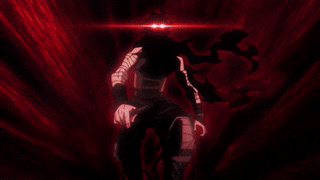 With the full Rhetorical Analysis paper due in just about 2 weeks, its about time to get to work on it. Starting to do this, I educated myself all about the background of the text, or scene, that I am analyzing (not that I didn’t know a lot to begin with). The work that I am analyzing is My Hero Academia. This is both a manga (comic) and anime (cartoon), although for the sake of this paper, I will mostly be dealing with the show as it better illustrates the mood and argument the author is trying to get across. This is due to the fact that the show can use color, music and smoothly moving frames to further drive the point home. The author of the original text of the comic’s story is Kohei Horikoshi while the writer of the show is Yosuke Kuroda. Also, another very important person to the impact of the scene is Kenji Nagasaki whom is the director. As the director, he controls what colors are where, how every character moves, and the music that plays over the background of the scene (with the help of Yuki Hayashi). This all culminates with the original writing to complete the argument that the scene is trying to convince you of. All of these artists have vary previous experience as well, which Horikoshi only working on some other pieces before this, whilst Kuroda and Nagasaki have worked on many. Kuroda has even won the Individual Award at the 8th Animation Kobe event for previous works. This piece was published by Studio Bones in 2016 to present.
With the full Rhetorical Analysis paper due in just about 2 weeks, its about time to get to work on it. Starting to do this, I educated myself all about the background of the text, or scene, that I am analyzing (not that I didn’t know a lot to begin with). The work that I am analyzing is My Hero Academia. This is both a manga (comic) and anime (cartoon), although for the sake of this paper, I will mostly be dealing with the show as it better illustrates the mood and argument the author is trying to get across. This is due to the fact that the show can use color, music and smoothly moving frames to further drive the point home. The author of the original text of the comic’s story is Kohei Horikoshi while the writer of the show is Yosuke Kuroda. Also, another very important person to the impact of the scene is Kenji Nagasaki whom is the director. As the director, he controls what colors are where, how every character moves, and the music that plays over the background of the scene (with the help of Yuki Hayashi). This all culminates with the original writing to complete the argument that the scene is trying to convince you of. All of these artists have vary previous experience as well, which Horikoshi only working on some other pieces before this, whilst Kuroda and Nagasaki have worked on many. Kuroda has even won the Individual Award at the 8th Animation Kobe event for previous works. This piece was published by Studio Bones in 2016 to present.
The cast of My Hero Academia is filled with people with superpowers and either use them for good or evil. The problem occurred, and this argument starts, when someone basically uses their superhuman ability to do both. The context is that, after being knocked out and tied up for almost killing several people, Stain wakes up and proceeds to save one of the heroes, Midoriya, from another villian. He kills the villian in the process and then turns around to the rest of the heroes, some of which are the most powerful in this world, and gives them a speech on what it means to be a hero. This leads to the heroes being unable to move under his overwhelming resolve and terror. Thus the argument that the author is trying to get across births itself.
The argument in this scene is that there is no such thing as pure good or pure evil. Using this toward his mostly young adult (teens to late 20s) Horikoshi has Stain play both parts by both saving a heroes life, while taking another person’s life at the same time. At the same time he has the character explain his resolve in a screen of just red and black. These elements all culminate together to create a great argument using logos (the character’s reasoning), Ethos (the strongest heroes’ fear), and Pathos (the coloring of the scene).
Comic Show
vvvvvvv vvvvvvvvvvv





